Having a strong online presence is essential for businesses and individuals alike.
And at the core of any successful online strategy lies Search Engine Optimization (SEO).
By optimizing your website and content for search engines, you can increase your visibility, attract organic traffic, and ultimately drive conversions.
But how can you know if your SEO efforts are paying off? This is where measuring and tracking SEO results becomes crucial.
In this article, we will explore the importance of measuring and tracking SEO results, as well as delve into the best practices to effectively analyze and interpret the data.
By understanding the significance of each metric and implementing the recommended practices, you can gain valuable insights into the performance of your SEO strategy and make informed decisions to improve your online presence.
Here is what you will read in this article:
![]()
They say that what gets measured gets improved.
This principle holds true not only in business but also in the realm of SEO.
To demonstrate the value of SEO and drive success, it's essential to measure and track its results.
By analyzing SEO performance, from rankings and conversions to lost links and more, you can continuously improve your strategies and achieve optimal outcomes.
Measuring and tracking SEO results play a critical role in driving SEO success, client retention, and perceived value.
It allows you to adapt your priorities, refine your approach, and align your efforts with the ultimate goal of achieving higher conversions, enhancing user experience, and leveraging user intent effectively.
When it comes to measuring and tracking SEO results, it's crucial to follow best practices and focus on key metrics that provide meaningful insights.
By understanding and monitoring these metrics, you can gain valuable data to guide your SEO strategies.
Let's explore some essential practices for measuring SEO results:
Organic traffic is the lifeblood of SEO.
It represents the number of visitors who land on your website through unpaid search engine results.
Tracking organic traffic allows you to understand how effectively your SEO strategy is attracting visitors and increasing your website's visibility.
Tools like Domain Overview and Traffic Analytics can help you gain a comprehensive view of your website's traffic sources and understand how your audience interacts with your site.
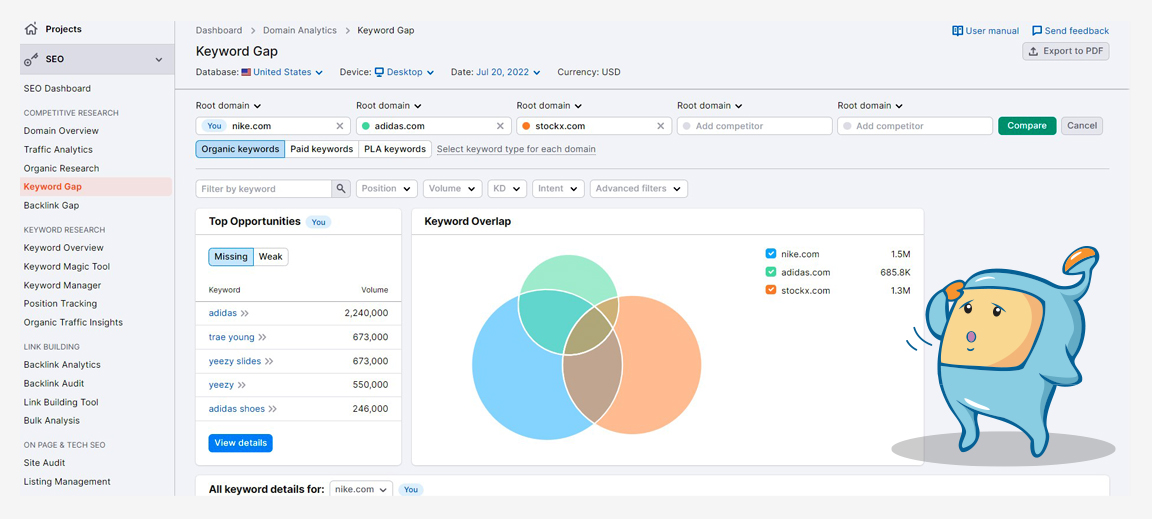
Monitoring keyword rankings is vital to assess your website's performance in search engine results pages (SERPs).
By tracking keyword rankings, you can gauge the impact of your SEO efforts on improving your website's visibility for specific search terms.
Conducting a keyword gap analysis can further enhance your understanding of your keyword performance and uncover new relevant search terms.
The click-through rate (CTR) measures the percentage of users who click on your website's link in search engine results after seeing it.
A high CTR indicates that your website's title tags and meta descriptions are compelling and appealing to users.
Analyzing CTR data, available in tools like Google Search Console, helps you identify areas for improvement in meta descriptions, titles, URLs, and featured snippets relevant to your business.
Search engine visibility refers to how frequently your website appears in search engine results for relevant queries.
Monitoring search engine visibility metrics allows you to understand your website's overall presence and visibility in search results.
Tools like Position Tracking can assist you in tracking your website's visibility and identifying opportunities to rank for featured snippets.

While driving traffic is important, the ultimate goal of SEO is to generate conversions.
Whether it's form submissions, purchases, or other desired actions, tracking conversions helps you measure the effectiveness of your SEO strategy in driving meaningful results.
Setting up custom goals in Google Analytics allows you to monitor conversion rates and estimate the return on investment (ROI) provided by your website visitors.
The bounce rate represents the percentage of visitors who leave your website after viewing only one page.
A high bounce rate may indicate issues with your website's user experience or the content's relevancy to visitors' expectations.
While minimizing bounce rate is often considered desirable, it's important to interpret this metric in the context of user experience.
Some pages, such as contact or informational pages, naturally have a higher bounce rate.
Instead, consider assessing the quality of your pages through metrics like scroll depth, which indicate user engagement.
Evaluating your website's authority over time provides insights into its credibility and reputation in the eyes of search engines.
Metrics like domain authority or page authority can indicate the strength of your website's backlink profile and overall authority.
Tracking your website's authority score, such as SEMrush's Authority Score, helps you understand your site's ranking potential and compare it to your competitors.
A higher Authority Score on SEMrush's logarithmic scale of 1 to 100 indicates greater traffic and higher rankings for your website.
Conversely, a lower score can lead to reduced traffic and lower rankings.
Comparing your domain authority score to that of your competitors allows you to fine-tune your SEO tactics and strive to outperform them.
Newly created websites typically start with an authority score of 1, and it takes time for most websites in the 40-60 range to establish authority, build backlinks, and attract organic visitors consistently.
If you don't see instant results, don't lose hope. Authority metrics progress gradually, so perseverance and a long-term strategy are key to achieving sustainable growth.
Backlinks play a crucial role in SEO as they signal to search engines the credibility and relevance of your website.
Monitoring backlinks helps you assess the quantity and quality of incoming links.
Aim for high-quality backlinks from reputable sources, as they can contribute to higher search engine rankings and increased organic traffic.

Page speed is a critical factor in user experience and search engine rankings.
Slow-loading pages can negatively impact user satisfaction and lead to higher bounce rates.
Faster-loading websites tend to have lower bounce rates and higher user engagement.
You can use tools like Google's PageSpeed Insights to evaluate your website's speed and provide recommendations for improvement.
If a website takes more than 10 seconds to load, its bounce rate can increase by nearly 120 percent.
To assess the speed of your website, you can utilize Google's PageSpeed Insights tool.
A score of 100 percent indicates excellent speed performance. Ideally, you should aim for a score of 90 or higher but below 100, which is considered good.
If your score falls between 50 and 90, there is room for improvement.
However, a score below 50 percent is considered poor and requires immediate attention to enhance the loading speed.
Aim for a quick score above 90 to ensure optimal performance.
The average time spent on a page indicates how engaging and valuable your content is to visitors.
Tracking this metric helps you understand user behavior and identify pages that captivate visitors for longer periods.
Focus on creating high-quality content that encourages visitors to spend more time on your website.
Be sure to also consider the purpose of each page when assessing the time spent metric.
Implementing an effective SEO strategy takes time and consistent effort.
The timeline for seeing SEO results can vary based on factors such as the age of your website, the effectiveness of your SEO approach, and the competitiveness of your target keywords.
Generally, it's realistic to expect visible results within four to twelve months, provided you are implementing best practices and maintaining a consistent SEO effort.
Keep in mind that results may vary depending on your competition and the specific metrics you are tracking.
Backlink-related metrics may show quicker results, while keyword rankings and site authority may require more time to develop.
Measuring and tracking SEO results is crucial for optimizing your website's performance, increasing organic traffic, and driving meaningful conversions.
By following best practices and monitoring key metrics, you can make data-driven decisions, continuously improve your SEO strategies, and enhance your online presence.
Embrace the power of data and periodically evaluate your SEO results to stay ahead in the competitive digital landscape.
Remember, gaining knowledge of best practices and focusing on conversion optimization is key to achieving long-term success in your SEO journey.
So, start measuring, tracking, and optimizing your SEO efforts to unleash the true potential of your website.